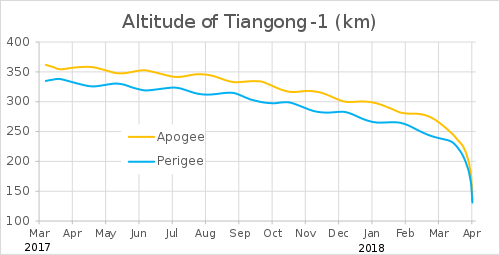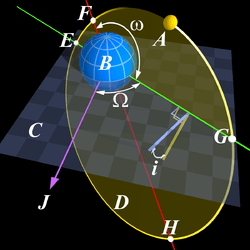Orbital decay
In orbital mechanics, decay is a gradual decrease of the distance between two orbiting bodies at their closest approach (the periapsis) over many orbital periods. These orbiting bodies can be a planet and its satellite, a star and any object orbiting it, or components of any binary system. Orbits do not decay without some friction-like mechanism which transfers energy from the orbital motion. This can be any of a number of mechanical, gravitational, or electromagnetic effects. For bodies in low Earth orbit, the most significant effect is atmospheric drag.

| Part of a series on |
| Astrodynamics |
|---|
 |
|
Orbital parameters |
|
Gravitational influences |
|
Preflight engineering |
|
Efficiency measures |
If left unchecked, the decay eventually results in termination of the orbit when the smaller object strikes the surface of the primary; or for objects where the primary has an atmosphere, the smaller object burns, explodes, or otherwise breaks up in the larger object's atmosphere; or for objects where the primary is a star, ends with incineration by the star's radiation (such as for comets), and so on.
Collisions of stellar-mass objects usually produce cataclysmic effects, such as gamma-ray bursts.
Due to atmospheric drag, the lowest altitude above the Earth at which an object in a circular orbit can complete at least one full revolution without propulsion is approximately 150 km (90 mi).
Causes
Atmospheric drag
Atmospheric drag at orbital altitude is caused by frequent collisions of gas molecules with the satellite. It is the major cause of orbital decay for satellites in low Earth orbit. It results in the reduction in the altitude of a satellite's orbit. For the case of Earth, atmospheric drag resulting in satellite re-entry can be described by the following sequence:
- lower altitude → denser atmosphere → increased drag → increased heat → usually burns on re-entry
Orbital decay thus involves a positive feedback effect, where the more the orbit decays, the lower its altitude drops, and the lower the altitude, the faster the decay. Decay is also particularly sensitive to external factors of the space environment such as solar activity, which are not very predictable. During solar maxima the Earth's atmosphere causes significant drag up to a hundred kilometers higher than during solar minima.
Atmospheric drag exerts a significant effect at the altitudes of space stations, space shuttles and other manned Earth-orbit spacecraft, and satellites with relatively high "low earth orbits" such as the Hubble Space Telescope. Space stations typically require a regular altitude boost to counteract orbital decay (see also orbital station-keeping). Uncontrolled orbital decay brought down the Skylab space station, and (relatively) controlled orbital decay was used to de-orbit the Mir space station.
Reboosts for the Hubble Space Telescope are less frequent due to its much higher altitude. However, orbital decay is also a limiting factor to the length of time the Hubble can go without a maintenance rendezvous, the most recent having been performed successfully by STS-125, with space shuttle Atlantis in 2009. Newer space telescopes are in much higher orbits, or in some cases in solar orbit, so orbital boosting may not be needed.[2]
Tidal effects
An orbit can also decay by negative tidal acceleration when the orbiting body is large enough to raise a significant tidal bulge on the body it is orbiting and is either in a retrograde orbit or is below the synchronous orbit. This saps momentum from the orbiting body and transfers it to the primary's rotation, lowering the orbit's altitude.
Examples of satellites undergoing tidal orbital decay are Mars' moon Phobos, Neptune's moon Triton, and the extrasolar planet TrES-3b.
Light and thermal radiation
Small objects in the Solar System also experience an orbital decay due to the forces applied by asymmetric radiation pressure. Ideally, energy absorbed would equal blackbody energy emitted at any given point, resulting in no net force. However, the Yarkovsky effect is the phenomenon that, because absorption and radiation of heat are not instantaneous, objects which are not terminally locked absorb sunlight energy on surfaces exposed to the Sun, but those surfaces do not re-emit much of that energy until after the object has rotated, so that the emission is parallel to the object's orbit. This results in a very small acceleration parallel to the orbital path, yet one which can be significant for small objects over millions of years. The Poynting-Robertson effect is a force opposing the object's velocity caused by asymmetric incidence of light, i.e., aberration of light. For an object with prograde rotation, these two effects will apply opposing, but generally unequal, forces.
Gravitational radiation
Gravitational radiation is another mechanism of orbital decay. It is negligible for orbits of planets and planetary satellites (when considering their orbital motion on time scales of centuries, decades, and less), but is noticeable for systems of compact objects, as seen in observations of neutron star orbits. All orbiting bodies radiate gravitational energy, hence no orbit is infinitely stable.
Electromagnetic drag
Satellites using an electrodynamic tether, moving through the Earth's magnetic field, creates drag force that could eventually deorbit the satellite.
Stellar collision
The coming together of two binary stars when they lose energy and approach each other. Several things can cause the loss of energy including tidal forces, mass transfer, and gravitational radiation. The stars describe the path of a spiral as they approach each other. This sometimes results in a merger of the two stars or the creation of a black hole. In the latter case, the last several revolutions of the stars around each other take only a few seconds.[3]
Mass concentration
While not a direct cause of orbital decay, uneven mass distributions (known as mascons) of the body being orbited can perturb orbits over time, and extreme distributions can cause orbits to be highly unstable. The resulting unstable orbit can mutate into an orbit where one of the direct causes of orbital decay can take place.
References
- "Tiangong-1 Orbital Status". Official Website of China Manned Space. China Manned Space Engineering Office. 1 April 2018. Retrieved 1 April 2018.
- The Hubble Program - Servicing Missions - SM4
- "INSPIRAL GRAVITATIONAL WAVES". LIGO. Retrieved 1 May 2015.